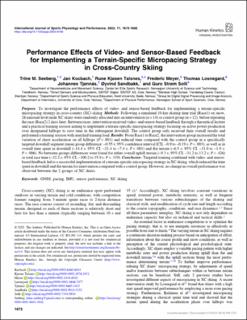| dc.contributor.author | Seeberg, Trine Margrethe | |
| dc.contributor.author | Kocbach, Jan | |
| dc.contributor.author | Talsnes, Rune Kjøsen | |
| dc.contributor.author | Meyer, Frederic | |
| dc.contributor.author | Losnegard, Thomas Johansen | |
| dc.contributor.author | Tjønnås, Johannes | |
| dc.contributor.author | Sandbakk, Øyvind | |
| dc.contributor.author | Solli, Guro Strøm | |
| dc.date.accessioned | 2023-02-23T13:14:47Z | |
| dc.date.available | 2023-02-23T13:14:47Z | |
| dc.date.created | 2022-11-09T09:21:56Z | |
| dc.date.issued | 2022 | |
| dc.identifier.citation | International Journal of Sports Physiology and Performance (IJSPP). 2022, 17 (12), 1672-1682. | en_US |
| dc.identifier.issn | 1555-0265 | |
| dc.identifier.uri | https://hdl.handle.net/11250/3053637 | |
| dc.description.abstract | Purpose: To investigate the performance effects of video- and sensor-based feedback for implementing a terrain-specific micropacing strategy in cross-country (XC) skiing.
Methods: Following a simulated 10-km skating time trial (Race1) on snow, 26 national-level male XC skiers were randomly allocated into an intervention (n = 14) or control group (n = 12), before repeating the race (Race2) 2 days later. Between races, intervention received video- and sensor-based feedback through a theoretical lecture and a practical training session aiming to implement a terrain-specific micropacing strategy focusing on active power production over designated hilltops to save time in the subsequent downhill. The control group only received their overall results and performed a training session with matched training load.
Results: From Race1 to Race2, the intervention group increased the total variation of chest acceleration on all hilltops (P < .001) and reduced time compared with the control group in a specifically targeted downhill segment (mean group difference: −0.55 s; 95% confidence interval [CI], −0.9 to −0.19 s; P = .003), as well as in overall time spent in downhill (−14.4 s; 95% CI, −21.4 to −7.4 s; P < .001) and flat terrain (−6.5 s; 95% CI, −11.0 to −1.9 s; P = .006). No between-groups differences were found for either overall uphill terrain (−9.3 s; 95% CI, −31.2 to 13.2 s; P = .426) or total race time (−32.2 s; 95% CI, −100.2 to 35.9 s; P = .339).
Conclusion: Targeted training combined with video- and sensor-based feedback led to a successful implementation of a terrain-specific micropacing strategy in XC skiing, which reduced the time spent in downhill and flat terrain for intervention compared with a control group. However, no change in overall performance was observed between the 2 groups of XC skiers. | en_US |
| dc.language.iso | eng | en_US |
| dc.publisher | Human Kinetics | en_US |
| dc.rights | Navngivelse-Ikkekommersiell 4.0 Internasjonal | * |
| dc.rights.uri | http://creativecommons.org/licenses/by-nc/4.0/deed.no | * |
| dc.title | Performance Effects of Video- and Sensor-Based Feedback for Implementing a Terrain-Specific Micropacing Strategy in Cross-Country Skiing | en_US |
| dc.title.alternative | Performance Effects of Video- and Sensor-Based Feedback for Implementing a Terrain-Specific Micropacing Strategy in Cross-Country Skiing | en_US |
| dc.type | Peer reviewed | en_US |
| dc.type | Journal article | en_US |
| dc.description.version | publishedVersion | en_US |
| dc.rights.holder | © 2022 The Authors | en_US |
| dc.source.pagenumber | 1672-1682 | en_US |
| dc.source.volume | 17 | en_US |
| dc.source.journal | International Journal of Sports Physiology and Performance (IJSPP) | en_US |
| dc.source.issue | 12 | en_US |
| dc.identifier.doi | 10.1123/ijspp.2022-0106 | |
| dc.identifier.cristin | 2070960 | |
| dc.relation.project | Norges forskningsråd: 270791 | en_US |
| cristin.ispublished | true | |
| cristin.fulltext | postprint | |
| cristin.qualitycode | 1 | |

